
Recently on Cyclingnews.com |
Tales from the peloton, November 18
Remembering Jacques Anquetil
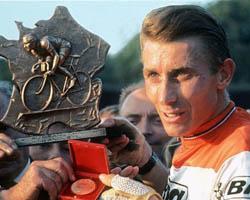
|
Despite claiming five Tour de France victories during his career, Jacques Anquetil didn't command the public's respect to the extent of other French cyclists until after his career had ended. Some 20 years after his passing, Cyclingnews' Les Woodland remembers the late rider's career.
On one side of Rouen in France is a hill called the côte de Bon Secours, after the village that stands at its summit. Its role in history is that it is there that the short, pugnacious and unpleasant Jean Robic attacked in the Tour de France of 1947 and grabbed the lead on the last day. That was against the spirit of the event, for even in those days there was an understanding that the maillot jaune should be allowed a tranquil last day's ride into Paris.
It should come as no surprise that Robic thought otherwise because this, as the Paris-Roubaix winner, André Mahé, recalled was a man who would stand in the doorway of restaurants until everyone had spotted him and then announce "Oui! C'est moi – Robic!" If you were going to have the Tour grabbed from you on the last day then a foul-mouthed, disagreeable man like Robic was the last person you'd choose to do it. That was certainly what Pierre Brambilla thought, anyway, because legend says he went home and buried his bike in the garden in disgust.
Through the middle of Rouen flows the river Seine. It was in Rouen that the English burned Joan of Arc and it was into the Seine, although upstream in Paris, that they flung her ashes. Where you cross the Seine on the way from the côte de Bon Secours is the industrial suburb of Sotteville, and it was there that a rather more likable Frenchman set fire not to a French visionary but to the whole Tour de France. For it was here in Sotteville that a young Jacques Anquetil joined his first and only cycling club, the Auto-Cycle Sotteville. He chose it not because he lived there, but because Sotteville was where he was studying metal work.
"If I win, my contract fees won't go up but if I lose to Poulidor then they'll go down."-Jacques Anquetil had unusual motivation to go for a sixth Tour win |
Leave Rouen now by the north and a long straight road heads almost straight towards the distant Belgian border. The first village of any consequence that it crosses is Quincampoix, although if you don't get held up at the single set of traffic lights then you may miss it. The sign welcoming you to the village is on one side of the lights and the sign wishing you farewell is on the other. The main village is down a turning to the left but between the two signs on the main road is a tall, black, gently curved monument that praises the village's most celebrated son. It shows his picture and lists all his victories.
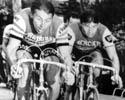
|
Jacques Anquetil, the most enigmatic of all Tour de France riders, died 20 years ago on November 18, 1987. On your way out of Rouen you may well see signs for the St-Hilaire clinic where he died of cancer. And if you turn left at the Quincampoix traffic lights and go the length of the wide main street to the church at the end, there in the second row of gravestones to the right you'll find Jacques Anquetil's last resting place. On the black marble stone is an engraving of him racing in his pale blue jersey of the Ford-France team and on the grave itself lies a stone, open book, a curious symbol because Anquetil's life was at the same time an open book and a firmly closed one.
You'd think the French would love Anquetil for being the first man to win the Tour five times as much as Americans worship Lance Armstrong for finally beating that record, exactly 40 years later. But to this day France has no more idea what to make of him than it did at the time. Yes, they're grateful for what he did but, no, they think Raymond Poulidor was by far the nicer rider.
Poulidor and Anquetil spent a whole career at each other's throats. Only once Anquetil had stopped racing did they make up, and only then because Poulidor came to ask Anquetil for a signed hat for his son.

|
"Raymond, all your life you've been making yourself a nuisance to me and now your son obviously plans to do the same," he laughed, fetching a cap and signing it.
Until then, Anquetil had been first cross and then despairing that whatever he did, however many times he won the Tour, he was always less popular than Poulidor with the fans. Anquetil sometimes even got hissed and whistled, even after five Tour wins, while Poulidor was adored for not winning anything very much at all.
The further oddity is that the positions were reversed within the peloton itself, where Anquetil was a favourite for everyone – even though he never bothered to learn most of their names – and acquired the honourable title of 'Maître Jacques', a tribute employed rarely in France and then only for lawyers and the like.
Poulidor, on the other hand, was disliked for being a moaner, a rider who told reporters that he lost races because other riders weren't up to it, a man always with a ready excuse for his shortcomings. There were even times when the field ganged up against him, making sure Anquetil could win. And even when Anquetil wasn't there, as when he abandoned his last Tour in 1966, they quietly made sure that it was Anquetil's little-regarded team-mate, Lucien Aimar, who won and not Poulidor.
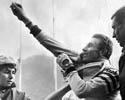
|
The problem was that Anquetil was dull. In every sense off the bike he was outrageous. He lived the life of a playboy (although not in the full sense, since his wife Jeanine accompanied him everywhere, and his not-quite-incestuous relationships with other women related to him needs a book to explain). But on the bike, he did not a stroke more than was needed to win. Miguel Indurain may not have set the world burning and Lance Armstrong may have been predictable, but at least both pulled off spectacular stunts and tried to win the Tour by as large a margin as possible. Anquetil, on the other hand, would have been happier to win by a second rather than hour because he got the same money regardless.
It was only with misgivings that he tried for a sixth Tour win, since as he said: "If I win, my contract fees won't go up but if I lose to Poulidor then they'll go down."
That languid style was coupled with a privilege that Anquetil had but neither Indurain nor Armstrong did: he could talk openly about drugs. Anquetil began racing in an era when doping was considered not only normal but wise. Drugs were called stimulants and were therefore just a means of stimulating the talent that was already there.
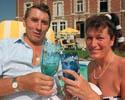
|
Anquetil was a philosophical man and, while he recognised – because it was obviously true – that riders went better with drugs than without, he argued in a way that few riders could manage. Specifically, he argued for drugs in cycling as a human right, saying it was no more logical to condemn a cyclist for trying to lessen his pain than it was to criticise a geography teacher for assuaging his headache with an aspirin.
In that he was wholly open. The French journalist Pierre Chany, who although close to Anquetil was never beyond criticising him, praised him not necessarily for his stance but for his honesty. Ask Anquetil what he had taken for a race and he would tell you, he said. He never hid the facts or looked away, as other riders did.
The trouble was that attitudes changed in Anquetil's time. Until the late 1950s, races were always reported in heroic tone. Riders were gods of the mountains; they rode lone calvaries on the plains; they suffered at hands of the green-toothed giant with a hammer so beautifully drawn by the cartoonist Pellos. Questions were never asked.
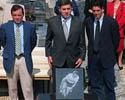
|
In the 1960s, that tone began to change. In 1966, when riders went on strike at Bordeaux to protest at drug tests introduced in the Tour, tolerance began to wear thin. Then when Tom Simpson died in the following year's Tour with drugs in his blood as well as his back pocket, there was little further sympathy for Anquetil's arguments.
France quietly dropped him from its world championship team and, in return, Anquetil pointedly rode his last race not in France but in Belgium. And now lies at Quincampoix, closed eyes upwards towards the stars he used to look at through a telescope for night after night. In truth, he was probably no heavier a drug-taker than many other riders.
It is rarely the most talented who take drugs most, if only because they don't need to. But it is with drugs, rather than his five Tour wins, that he is most quickly associated. Completing a sad cycle, in that the last building you see in Quincampoix, on the right as you enter the graveyard, is a pharmacy.
Photography
For a thumbnail gallery of these images, click here
Images by AFP Photo
- Jacques Anquetil races head-to-head with arch rival Raymond Poulidor in 1964.
- The Frenchman is recognised in 1966 for his commitment to an athletic career.
- Jacques Anquetil, wearing the yellow jersey, rides to victory on the 19th stage of the Tour de France in 1963, an Individual Time Trial between Arbois and Besançon.
- Anquetil puts on the leader's jersey at the 1963 Tour de France.
- Frenchman Jacques Anquetil does a victory lap at the Parc des princes in Paris after capturing his fourth Tour de France on July 14, 1963. Anquetil previously won in 1957, 1961 and 1962.
- Jacques Anquetil recieves a trophy in 1969 as he retires from the sport.
- A relaxed Jacques Anquetil just three months before his passing in 1987.
- Raymond Poulidor, Jean Stablinski and Eugène Letendre show their respect at Anquetil's funneral in 1987.
- Jacques son Christopher Anquetil uncovers a tribute to the great rider in 1997, 10 years after his passing.
- Former cyclists, France's Bernard Hinault, Belgian Eddy Merckx and Spaniard Miguel Indurain mourn at the tomb of Jacques Anquetil in Quincamoix in July 2005, who like them won the Tour the France five times.
